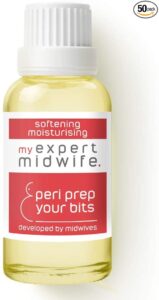An episiotomy is a surgical cut made at the opening of the vagina during childbirth.
Around 1 in 7 deliveries in England involves an episiotomy. Sometimes a woman’s perineum may tear as their baby comes out, resulting in similar issues. The tear or cut will need stitching following the birth.
The National Institute for Health and Care Excellence (NICE) recommends that an episiotomy might be done if:
-
the baby is in distress and needs to be born quickly, or
-
there is a need for forceps or vacuum (ventouse), or
-
there is a risk of a tear to the anus
Thanks to our friends over at Mayoclinic we can describe the two types of episiotomy incisions:
There are two types:
-
Midline (median) incision. A midline incision is done vertically. A midline incision is easier to repair, but it has a higher risk of extending into the anal area.
-
Mediolateral incision. A mediolateral incision is done at an angle. A mediolateral incision offers the best protection from an extended tear affecting the anal area, but it is often more painful and is more difficult to repair.
There are also varying degrees of tear (thanks this time to the lovely authors over at Cleveland Clinic):
-
First-degree tear: The least severe of tears, this small injury involves the first layer of tissue around the vagina and perineal area.
-
Second-degree tear: This second level of this injury is actually the most commonly seen tear during childbirth. The tear is slightly bigger here, extending deeper through the skin into the muscular tissue of the vagina and perineum.
-
Third-degree tear: A third-degree tear extends from your vagina to your anus. This type of tear involves injury to the skin and muscular tissue of the perineal area, as well as damage to the anal sphincter muscles. These muscles control your bowel movements.
-
Fourth-degree tear: This is the least common type of tear during childbirth. Extending from the vagina, through the perineal area and anal sphincter muscles and into the rectum, this injury is the most severe type of tear.
Symptoms associated with episiotomy and perineum tears:
-
Pain at the incision site in the weeks / months following the surgery during the healing phase, especially when sitting.
-
Pain during sex.
-
Incontinence (faecal or urine). Please also see our page on incontinence for more treatment options.
-
Pain during bowel movement.
-
Bleeding.
-
Swelling in the area.
-
Formation of scar tissue. This is a normal part of healing but for some women, the scar tissue can cause issues, especially if it is particularly thick / excessive.
-
Fear of movement.
What the evidence says about preventing perineum tears / need for episiotomy:
Perineal massage – A lot of ladies are told about perineal massage but does it actually help? Research suggests that it certainly does. THIS study is a little old but was on a large scale and produced some pretty reliable results. They found that perineal massage, undertaken by the woman or her partner (for as little as once or twice a week from 35 weeks), reduced the likelihood of perineal trauma (mainly episiotomies) and ongoing perineal pain.
We really like THIS step by step guide by NCT on how to do perineal massage. You can buy specific oil for perineal massage here.
Pelvic Floor Exercises – THIS study found that a training programme composed of pelvic floor exercises and perineal massage, helped to prevent episiotomies and tears in first time mums. Have a look at this video for a great explanation on when and how to do your pelvic floor exercises.
Yoga – There is a lot of evidence to say that yoga can help prevent injury during birth. There are lots of Online Yoga programmes available, have a look at our Top 5 here (and why we love them)! You can also read our blog on how yoga can help in other ways.

Pilates – Evidence has also shown that Pilates can also have a positive effect on the birth and the outcome following the birth. This study compared Pilates with standard pelvic floor exercises and concluded that the Pilates exercise program was as effective as conventional pelvic floor exercises.
Have a look at our Top 5 Online Pilates programmes here.
Water birth – Evidence is mixed when it comes to water births (or labour in water). It appears as though the water is helpful in pain relief but doesn’t necessarily help to prevent tears or the need for interventions such as episiotomies.
Treatment recommendations in the first 24hrs+ after episiotomy or perineal tear:
Kegel exercises – evidence is good for the use of this type of exercise before and immediately after birth. Studies have shown that they can help with urinary incontinence as well as pain / recovery after birth. Here is a great video explaining how to do Kegel exercises.
Cold therapy – We know that cold can help to reduce pain and inflammation. Do not do this more than three times a day however, as this can reduce blood flow to the area and slow healing. You could use ice wrapped in a towel or you can buy specific cold packs for perineum pain like these that stick into your underwear and can be used at any time as they do not need to be frozen to activate the cooling effect:

Doughnut cushions – a lot of studies have been carried out in order to check the effects of doughnut cushions on pressure relief. The studies are always in their favour, so if pain is your main issue then something like this might help to take some of the pressure off the affected area. Various types of cushions are on the market, have a look at our Top 5 pressure relief cushions HERE.

Heat – warm baths have been recommended to encourage healing following tears / cuts in this area. Heat demonstrated therapeutic benefit for both analgesia and promoting healing in certain injuries. Wait until 24 hours after you have given birth to take a bath and make sure that the bathtub is cleaned with a disinfectant before every bath.

Sitz Bath – A Sitz bath is where one sits in water that covers your vulvar area a few times a day to help with pain and healing. It isn’t easy finding evidence for it’s effectiveness but it’s there if you dig deep enough. This older study compared cold and hot Sitz baths for relief of postpartum perineum pain and found that cold Sitz baths were significantly more effective in relieving perineal pain and can help with keeping the area clean. You can buy a collapsible Sitz bath with great reviews HERE.
Lavender – This very recent study showed that the use of Lavender (in any form), following the birth of a baby, had a significant effect on pain relief and healing of episiotomy wounds. We would recommend using a lavender essential oil such as THIS one by Hebeso. This can be added to a bath for a heating effect also.
Position changes – While being active will help circulation and encourage healing, rest is also important during these early days of healing. A good position to rest in is lying down with your feet elevated above your heart to aid in circulation and reduce pressure to the perineum.
Treatment recommendations weeks 1-6:
Exercises – While protocol suggests that we wait until our 6-week check up to get the go ahead for post-birth exercise, there are things that you can be doing in the first 6 weeks (and as early as 1 day post-op) that will help to aid your recovery.
Have a look at this video by Today Parent. This shows really clearly how to do the exercises that are recommended straight after birth (speak to your midwife about these on your first follow-up appointment).
Walking – Once you are up and moving after your birth then you want to stay as active as feels comfortable to you. Little and often is usually key to help with circulation and reduce any chances of a DVTs developing. THIS study found that mobilisation out of bed, with or without breathing exercises, within 2 hours after surgery improved arterial and peripheral oxygenation. This means quicker healing and less chances of complications (like DVTs).
Oats – There is a lot of talk about the role of oats in healing and reducing inflammation. We came across this recent, very large, detailed study which found very little evidence for the use of oats in the healing process (so you can lay off the porridge for now).
Treatment recommendations weeks 6+:
Perineal scar massage – We know from previous research that massage can really help with scar tissue in terms of pain, thickness, appearance and colour.
If you have had an episiotomy or a perineal tear, the scar tissue around the area can become tight and and less flexible. This may cause discomfort during intercourse and during physical activity. By massaging the perineal area, you can reduce / mobilise the scar tissue. It is recommended that you wait until you have had your postnatal check, (usually at six weeks) to start this massage. Your healthcare provider will check that your stitches or scar have fully healed. HERE is a great video explaining how you can help with your own scar tissue following episiotomy or tear in the perineal area.
Exercise – Getting back to fitness can be difficult when you have a new baby but the importance of regular exercise has been highlighted in a lot of studies. THIS study provides support for the effectiveness of exercise in reducing postpartum depressive symptoms. Group exercise, participant-chosen exercise, and exercise with co-interventions were all effective interventions. Basically, it doesn’t matter what you choose to do, it just matters that you do it regularly.
Pilates – Once you have had your 6 week check up and been given the all clear then you can usually start exercising again. Evidence does support the use of Pilates-based exercise during & after pregnancy for the treatment of many conditions including pelvic floor strength. Evidence has also shown that Pilates can also have a positive effect on the birth and the outcome following the birth. Have a look at our Top 5 Online Pilates programmes here.

Yoga – There have been a few studies looking into how yoga can help with healing after injury. One recent study found that yoga had a very significant improvement on the physical indicators and mental health of postpartum women. THIS study found that yogic practices enhance muscular strength and body flexibility, promote and improve respiratory and cardiovascular function, improve sleep patterns and enhance overall well-being and quality of life.
There are lots of Online Yoga programmes available, have a look at our Top 5 here (and why we love them)! You can also read our blog on how yoga can help in other ways.

Physiotherapy – It is recommended that you speak to / see a women’s health physiotherapist after 4 weeks (post tear / c-section). They can determine what sort of treatments might help you and give you some ideas on which symptoms are normal and will improve on their own and which might need a little more attention.
Symptoms to watch for following an episiotomy or tear:
-
Red / swollen skin around the wound that looks ‘angry’.
-
Persistent pain that isn’t easing.
-
A smell that isn’t usual for you and quite noticeable.
-
Pus or liquid coming from the cut.
Tell your GP, midwife or health visitor as soon as you can about any possible signs of infection, so they can make sure you get treatment.



